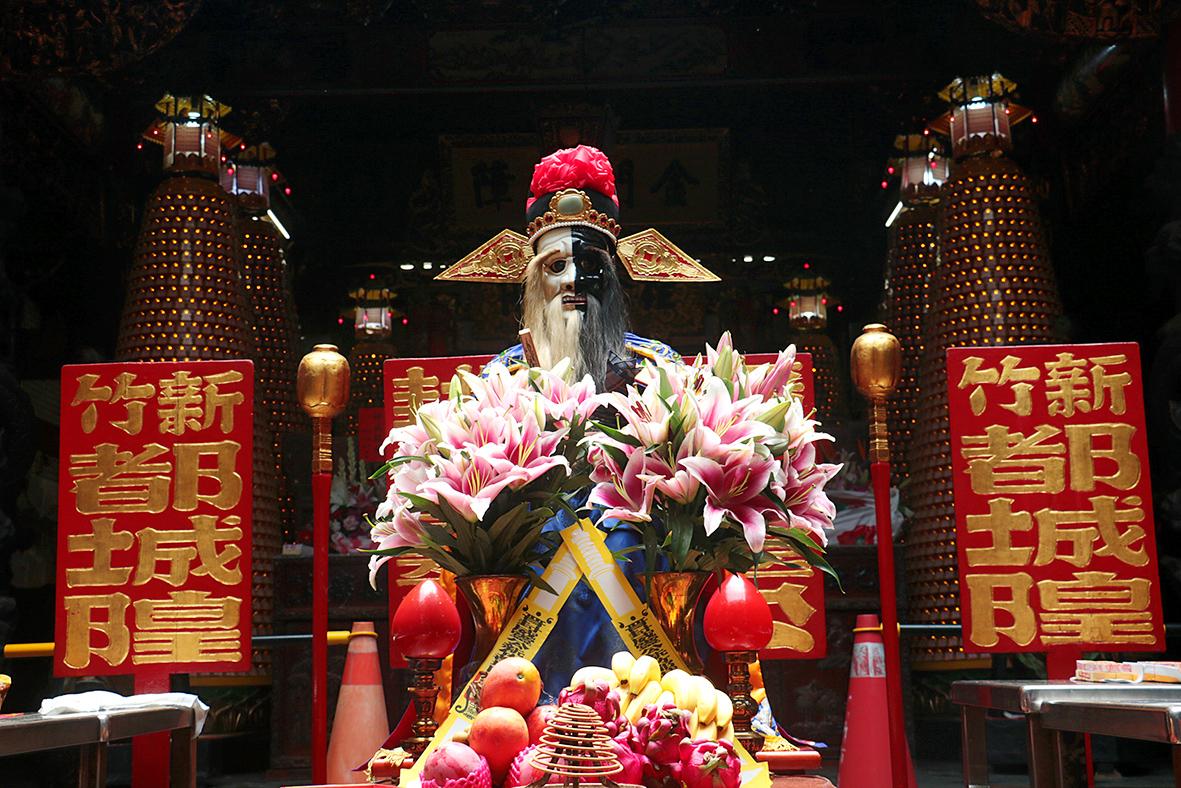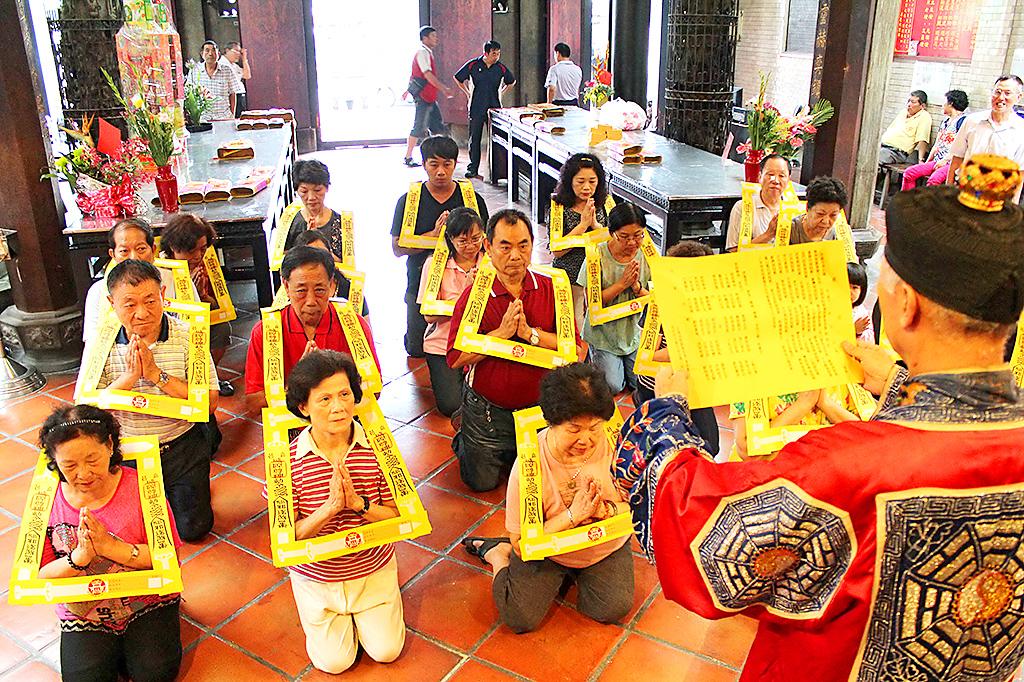Aug. 17 to Aug. 23
Ms Liu (劉) had a lot to be sorry about over the years.
She was rude to her parents, feuded with coworkers and often succumbed to greed. So when Chiayi’s Cheng Huang Temple (城隍廟) started offering “cangue processions” (夯枷) in 2014 at end of Ghost Month, Liu immediately signed up, she told the Liberty Times (Taipei Times’ sister newspaper).

Photo courtesy of Hsinchu County Government
A cangue is a large wooden board that was fitted around a criminal’s neck, a practise dating back to antiquity. Some included holes for arms. During the Qing Dynasty, a cangue could weight up to 40kg, and prisoners were paraded around the streets as a form of torture and humiliation.
Fortunately, Liu only had to wear a symbolic one made of paper. The participants announce, “I am a sinner and I’m willing to repent and correct my mistakes.” At the end of the procession, they present a “spiritual petition” (疏文) to the black-and-white faced yinyangsi (陰陽司), who serves as a chief assistant to the City God. They then burn the cangues along with the petitions.
Participants do not have to have committed any serious crimes. A woman surnamed Lou (婁) says she had a argument with her husband and badmouthed him to her friends, and she joined to alleviate her conscience and pray for their relationship.

Photo: Yu Hsueh-lan, Taipei Times
Chiayi’s ritual was stopped for about 60 years before its 2014 revival, while the event at Hsinchu’s City God Temple endured and remains the best-known version in Taiwan. It continues to grow in popularity, as last year’s procession in Hsinchu saw 2,310 cangue bearers, while Chiayi’s edition boasted about 300 participants.
This year, Hsinchu’s cangue procession takes place on Wednesday, which is the first day of Ghost Month, while Chiayi’s will fall on the day after the end of Ghost Month on Sept. 17.
TRADITION OF REPENTANCE

Photo courtesy of Trans-Asia Photography Review
City Gods are considered administrative and judicial officials of the underworld, and during the Ming and Qing dynasties, the temples they reside in have served as a spiritual counterparts to local government offices.
Many of the earlier City God Temples in Taiwan were set up by Qing officials, who built them in the administrative center of each new district. At the end of Qing rule of Taiwan in 1895, there were 15 state-built City God Temples and 16 private ones. They were given ranks and jurisdictions according to Qing administrative levels, and Hsinchu’s temple received the highest “capital” rank in 1889. Today there are over 90 temples across Taiwan with the City God as main deity.
The unique cangue ritual developed due to the City God’s reputation as a magistrate-deity.
The nation’s earliest description of cangue procession is found in a 1871 Qing gazetteer, which mentioned men and women walking in a Chungyuan Festival (中元, 15th day of Ghost Month) procession with paper cangues around their necks.
There are several types of paper cangues. Hsinchu’s version is a triangle symbolizing three swords against the bearer’s neck, while Chiayi employs a rectangle that looks more like the traditional wooden contraption.
According to the book Interaction Between Humans and Ghosts (人與鬼之交流) by Tsai Yi-hsin (蔡翊鑫), the Hsinchu City God Temple’s cangue ritual was first held in 1854. Back then, participants wore actual wooden cangues, and there was no procession since “sinners” were free to visit the yinyangsi anytime between the first and 15th day of Ghost Month. These wooden cangues have been lost to time.
The Canadian missionary George Leslie Mackay recalls in his diary seeing this procession in 1879 in Hsinchu, noting that many participants wore triangle cangues made by connecting three swords around their necks.
A local Hsinchu gazetteer from 1894 details local Chungyuan Festival celebrations through a poem, describing in one stanza an all-woman cangue procession.
It is unclear when Hsinchu’s procession was moved to the first day of Ghost Month.
The Taiwan Daily News (台灣日日新報) reported in 1908 that participants used sword, bamboo and paper cangues, but by 1918 it was all paper. The 1918 article, which was published about a week before the event, notes that 9,000 cangues had already been sold, showing that it was a much grander affair compared to today.
The procession continued to swell in numbers as a 1928 report notes that the temple prepared 12,000 paper cangues.
The cangues were a significant source of income for the temples, and still are. It costs NT$600 to participate in both Hsinchu and Chiayi, meaning that the Hsinchu temple earned over NT$1.3 million last year from the ritual. In 1882, a man named Liu Lue (柳略) was arrested for privately selling them. His punishment could not be more apt — he was fitted with a wooden cangue and paraded through the streets.
The ritual’s lowest point came in 1997, when the temple canceled it due to just six people signing up.
OTHER LOCALES
In 2014, Chiayi’s Cheng Huang Temple, built in 1715 and also dedicated to the City God, held a special night patrol for the second year in a row upon the end of ghost month to cleanse the area of lingering demons.
The temple told the Liberty Times that 2014 was especially turbulent — that year saw the Sunflower student movement, a random MRT slashing incident, the TransAsia Airways (復興航空) plane crash in Penghu, a series of deadly gas explosions in Kaohsiung and a truck attack on the Presidential Office, just to name a few events.
That year, the temple included the cangue ritual in its Ghost Month festivities for the first time in about 60 years.
The history of Chiayi Cheng Huang Temple’s cangue ritual is not well-documented. Eighty-year-old honorary temple director Yeh Yuan-chu (葉源助) recalls seeing an impressive procession when he was young, but does not know why it was discontinued.
Taipei’s Xiahai City God Temple also held this ritual at one point. Hung Chen-chin (洪陳勤), who grew up in Dadaocheng in the 1920s, tells Academia Historica that she recalls seeing a procession during the City God’s birthday festivities. Photos taken in 1949 still show participants wearing cangues, but the practice did not survive to modern day.
Taiwan in Time, a column about Taiwan’s history that is published every Sunday, spotlights important or interesting events around the nation that either have anniversaries this week or are tied to current events.

This month the government ordered a one-year block of Xiaohongshu (小紅書) or Rednote, a Chinese social media platform with more than 3 million users in Taiwan. The government pointed to widespread fraud activity on the platform, along with cybersecurity failures. Officials said that they had reached out to the company and asked it to change. However, they received no response. The pro-China parties, the Chinese Nationalist Party (KMT) and Taiwan People’s Party (TPP), immediately swung into action, denouncing the ban as an attack on free speech. This “free speech” claim was then echoed by the People’s Republic of China (PRC),

Exceptions to the rule are sometimes revealing. For a brief few years, there was an emerging ideological split between the Democratic Progressive Party (DPP) and Chinese Nationalist Party (KMT) that appeared to be pushing the DPP in a direction that would be considered more liberal, and the KMT more conservative. In the previous column, “The KMT-DPP’s bureaucrat-led developmental state” (Dec. 11, page 12), we examined how Taiwan’s democratic system developed, and how both the two main parties largely accepted a similar consensus on how Taiwan should be run domestically and did not split along the left-right lines more familiar in

Specialty sandwiches loaded with the contents of an entire charcuterie board, overflowing with sauces, creams and all manner of creative add-ons, is perhaps one of the biggest global food trends of this year. From London to New York, lines form down the block for mortadella, burrata, pistachio and more stuffed between slices of fresh sourdough, rye or focaccia. To try the trend in Taipei, Munchies Mafia is for sure the spot — could this be the best sandwich in town? Carlos from Spain and Sergio from Mexico opened this spot just seven months ago. The two met working in the

Many people in Taiwan first learned about universal basic income (UBI) — the idea that the government should provide regular, no-strings-attached payments to each citizen — in 2019. While seeking the Democratic nomination for the 2020 US presidential election, Andrew Yang, a politician of Taiwanese descent, said that, if elected, he’d institute a UBI of US$1,000 per month to “get the economic boot off of people’s throats, allowing them to lift their heads up, breathe, and get excited for the future.” His campaign petered out, but the concept of UBI hasn’t gone away. Throughout the industrialized world, there are fears that